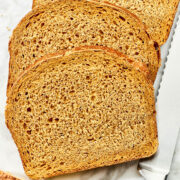Oatmeal Molasses Bread
A true Nova Scotia classic, this hearty oatmeal molasses bread is soft, slightly sweet, and perfect with butter, chowder, or baked beans.
Servings: 12 servings
Calories: 209kcal
Equipment
- Measuring cups and spoons or digital kitchen scale
- Large mixing bowl
- Small bowls
- Danish dough whisk or sturdy spoon
- Two 9 x 5-inch (23 x 13 cm) loaf tins (see recipe notes)
- Pastry brush
- Parchment paper
- Wire rack
Ingredients
- 1 cup rolled oats not quick oats
- 1 cup hot water 120°F to 140°F (49°C to 60°C)
- 2 tablespoons salted butter divided
- ¼ cup warm water 100°F to 110°F (38°C to 43°C)
- 1 ¼ teaspoons active dry yeast not rapid rise
- 1 teaspoon granulated sugar
- ½ cup molasses fancy, not blackstrap
- 1 teaspoon table salt
- 3 cups all-purpose flour plus up to ¼ cup (38 g) more for kneading
Instructions
- In a large mixing bowl, combine the rolled oats and hot water. Let sit for 10 minutes to soften the oats.
- Melt 1 tablespoon of the butter and set it aside.
- In a small bowl, mix the warm water, yeast, and sugar. Let stand for 10 minutes until the yeast is expanded and frothy.
- Add the yeast mixture, 1 tablespoon of melted butter, molasses, and salt to the oat mixture. Stir until well combined.
- Add the flour and stir until a shaggy dough forms, ensuring all dry bits of flour are incorporated.
- Turn the dough onto a lightly floured surface and knead for 10 minutes. Sprinkle flour whenever it sticks to the work surface or your hands. The dough should be smooth, elastic, and slightly tacky but not sticky.
- Shape the dough into a smooth ball and place it back in the mixing bowl, seam side down. Cover the bowl with a shower cap or damp tea towel, and let rise in a draft-free place for 1 hour, or until doubled in size.
- Line a 9 x 5-inch (23 x 13 cm) standard loaf pan with parchment paper and set it aside.
- Gently punch down the dough and divide it into two equal portions. Shape each portion into a ball, pinching the seams at the bottom to seal.
- Place the two dough balls on each end of the prepared loaf pan. Cover the pan and let the dough rise for another 45 minutes, or until it rises about 1 inch (3 cm) above the pan's rim.
- Preheat the oven to 425°F (220°C). Melt the remaining 1 tablespoon of butter and brush it over the dough. Place the second loaf tin upside down over the top of the pan to create a cover.
- Bake for 20 minutes, then carefully remove the top tin and continue baking for another 10 to 15 minutes. The loaf is done when the top is golden brown and sounds hollow when tapped. Remove the loaf from the pan and transfer it to a wire rack. Cool completely before slicing.
Notes
- Use a large mixing bowl to soak the oats, as all other ingredients will be added to this bowl later.
- The dough will be sticky at first but should become smooth and elastic after kneading; avoid adding too much flour, or the bread may be dry.
- Dough rising times can vary, so don’t rely only on the clock—look for the dough to double in size during the first rise and rise 1 inch (3 cm) above the pan in the second. If it hasn’t, give it more time.
- I use small binder clips to secure my parchment paper to the tin. If using plastic clips, remove them before baking.
- The trapped steam under the second loaf tin helps create a softer crust and even baking. If you don’t have a second loaf tin for covering, use a tented foil to trap steam.
Storage For Oatmeal Molasses Bread
- Store the bread in an airtight container at room temperature for up to three days.
- For longer storage, slice the cooled loaf and freeze in a sealed bag for up to two months.
- To thaw, let slices sit at room temperature for 20 minutes or toast straight from the freezer.
Nutrition
Serving: 1serving | Calories: 209kcal | Carbohydrates: 42g | Protein: 5g | Fat: 3g | Saturated Fat: 1g | Polyunsaturated Fat: 0.4g | Monounsaturated Fat: 1g | Trans Fat: 0.1g | Cholesterol: 5mg | Sodium: 217mg | Potassium: 282mg | Fiber: 2g | Sugar: 12g | Vitamin A: 58IU | Vitamin C: 0.001mg | Calcium: 41mg | Iron: 3mg
